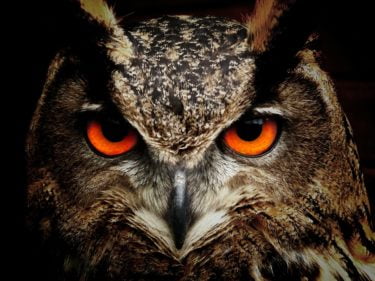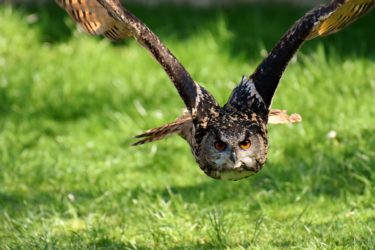On the evening of 12th September, 1952, a group of boys were playing football in the village of Flatwoods, West Virginia, when they noticed a bright light flare across the sky and appear to land on a nearby hill. Climbing the hill, they were terrified to discover an otherworldly creature staring at them. Standing between seven and twelve feet tall, it wore some sort of green cloak, out of which emerged spindly, claw-like hands. Worst of all were the burning red eyes, glaring at the children from under a black cowl. With an unearthly hiss the creature began to glide towards them. The witnesses ran for their lives, and soon the whole world knew of their encounter with the Flatwoods Monster.
Just three years later, on 21st August 1955, a similarly bizarre incident occurred 400 miles away outside the town of Hopkinsville, Kentucky. A gathering of family and friends were enjoying an evening meal when one of them noticed yet another bright light streaking across the sky. Soon afterwards their home came under attack from small, aggressive creatures. These were the archetypal little green men: just three feet tall, their bulbous heads sported pointy ears and bulging yellow eyes; their bodies were stocky and neckless, but their long arms ended in grasping, talon-like hands. Fearing for their safety, some of the group shot at the creatures, but they appeared impervious to bullets. Indeed, they seemed to toy with the humans, flipping and floating through the air with mocking agility. The family raced to the Hopkinsville police station for backup, but by the time they returned with the police the mysterious assailants were nowhere to be seen.
An equally terrifying event took place near the town of Point Pleasant, West Virginia, on 15th November 1966. Late that evening, two young couples were driving through the woods outside the town when they noticed a large, shambling figure with bright red eyes at the side of the road. Horrified, they sped away from the creature, but it unfolded an enormous pair of wings and chased them. Eventually managing to outpace it, the witnesses drove straight to police station to report their experience. Similar sightings soon began pouring in. The legend of the Mothman was born.
These three encounters have become some of the most iconic and influential episodes in cryptozoology and ufology, inspiring heated debate among believers to this day. I’m not going to try to debunk them here – that job’s already been done, thanks to detailed investigations by Joe Nickell, Renaud Leclet and others. So what unearthly creatures had these terrified people really encountered in 1952, 1955 and 1966?
Owls.
Sometimes in sceptical enquiry, the explanations are just as intriguing as the mysteries.
The trouble with owls
Let’s start with the Flatwoods Monster. The suggestion that this being was in fact an owl was raised by Air Force investigators just weeks after the incident took place. Joe Nickell explored this idea further in 2000, concluding that a female barn owl was the most likely identity of the monster. The bird, he posited, was perched seven to twelve feet off the ground, giving the impression of great height, while the long green cloak was merely foliage beneath the perch. The claw-like hands were talons, the black cowl was an illusion caused by the barn owl’s distinctive heart-shaped face, and the burning red glare was simply the result of the animal’s reflective eyes, which shine back light sources – such as the witnesses’ torches – with an eerie red glow.

French researcher Renaud Leclet reached a similar conclusion when he examined the Hopkinsville siege in 2001. The culprit this time was identified as an aggressive pair of great horned owls. These large birds stand about two feet tall, possess bright yellow eyes and distinctive ear tufts – the eponymoushorns – that could be confused for the aliens’ large, pointy ears. (The ‘talon-like’ hands were, unsurprisingly, talons.) Like the Hopkinsville aliens, great horned owls also possess the aerial agility to appear to flip and float in the air. Unlike the extraterrestrials, however, owls aren’t known for their bulletproof properties. Nevertheless, I can imagine that trying to shoot a pair of owls in the dark, in a house with no electric lights, while fearing for my family’s life, might be easier said than done.
And the Mothman? It seems some residents of Point Pleasant may have figured this out back in 1966: two other witnesses who saw the creature that year were clear that ‘it was definitely a bird.’ Joe Nickell has once again investigated these sightings, concluding that a barred owl – a common animal in the woods around the town – was probably what the young couples actually saw that November night. The barred owl’s large size and almost four-foot wingspan could, in the eyes of frightened witnesses, easily be magnified into Mothman’s monstrous dimensions, and its highly reflective eyes would explain the creature’s crimson stare.
As satisfying as these explanations are, they leave one niggling question unanswered: why owls? What is it about these seemingly innocuous creatures that drives terror into the hearts of men, women and children – not just once, but again and again?
The first thing to consider is that most owls – including all the species involved in these cases – are nocturnal or crepuscular, meaning that people are most likely to encounter them late in the evening or at night. This is significant: not only do poor light conditions make it harder to correctly identify what we’re looking at; they make it more likely that we’ll misidentify it. Darkness heightens fear and distorts perception. Our brains, after aeons of evolutionary adaptation, find it safer to exaggerate potential threats when we can’t rely on our vision to tell us what’s out there. Remember that the Flatwoods Monster and the Hopkinsville aliens both emerged at dusk, and that the Mothman made his appearance by the side of a dark road. In those situations, most of us would have overestimated the danger posed by something moving in the trees. Had I been part of the Flatwoods expedition that foggy September night, would I have bolted back home with the other witnesses? Absolutely.
By itself, however, nocturnal behaviour doesn’t entirely explain the trouble with owls. After all, plenty of other creatures are nocturnal, and yet I don’t remember any instances of people confusing moths, bats and foxes for interstellar monsters. So what other features of owl biology might be at work here?
Vocalisations could play a part. Owls are remarkable creatures, but they’re not the most tuneful of birds. Besides the mournful hoots familiar to most of us, these animals also make an unpleasant array of hisses, screams and shrieks. The hair-raising cries of the spot-bellied eagle owl, which sound unnervingly like a screaming woman, are thought to have given rise to the legend of the Sri Lankan devil bird, a demon said to bring death and disaster to those unfortunate enough to hear it.
Such unfamiliar and unsettling sounds may have heightened the horror of the three American owl encounters. Witnesses reported that the Flatwoods Monster uttered ‘something between a hiss and a high-pitched squeal,’ which tallies perfectly with the frankly disturbing noises made by the barn owl. The Mothman was similarly described as ‘squeak[ing] like a big mouse,’ which – while not exactly bone-chilling – would nevertheless have been disconcerting given the situation the young couples found themselves in.
Perhaps the most important clue to consider, however, is also the most distinctive feature of owls: their broad, flat faces and forward-facing eyes. Most birds – indeed, most animals – have eyes on either side of their head, which gives them a wide field of vision in which to spot approaching predators. The forward-facing eyes of owls, on the other hand, give them finely-tuned depth perception for hunting prey. It’s a trait shared only by other birds of prey, mammalian carnivores and primates – including us.
Why is this relevant? Because human brains, in addition to being wary of the dark, are always looking for human faces. It’s our old friend pareidolia once again: the brains’ willingness – desperation, almost – to find patterns where there are none, from Jesus in pancakes to blobsquatches in bushes. Seen in poor light, and in unsettling circumstances, an owl’s forward-facing eyes can trick us into thinking that the thing we’re looking at – or, perhaps more to the point, the thing looking at us – isn’t an animal, but a human-like being, whether a bestial monster like the Mothman or the manikin aliens of Hopkinsville. The owl’s vaguely human-looking face likely goes a long way to explaining why these birds have spawned more humanoid cryptid sightings than any other animal, with the possible exception of another animal with forward-facing eyes, the bear.
But if these monsters and aliens were simply misidentified owls, how do we explain their aggressive behaviour? Barn owls don’t normally advance on frightened children; barred owls rarely chase speeding cars, and great horned owls aren’t known for laying siege to houses.

Perhaps labelling these behaviours as aggressive, however, is to look at these situations the wrong way round: what if the owls weren’t being offensive, but defensive? Both Nickell and Leclet have suggested that the Flatwoods barn owl and the Hopkinsville great horned owls might have been rearing chicks at the time of their respective encounters, and would therefore have been especially keen to keep intruding humans away. (As someone who’s been dive-bombed for inadvertently straying too close to a bird nest I find this very easy to believe.) It’s true that barred owls are unlikely to be rearing young in November, when the Mothman was sighted, but remember that the Point Pleasant creature merely flew in the same direction as the witnesses’ car for a short while. When considered from the safety of our own homes, in the sanity of daylight, it hardly seems the act of an aggressive man-beast.
Ultimately, the trouble with owls comes down to our own ignorance of these fascinating animals. If familiarity breeds contempt, then unfamiliarity spawns monsters. Had an ornithologist been among the witnesses on those three fateful nights, chances are there would have been no misidentifications and thus no tales of close encounters. As it stands, though, most of us lack the experience and expertise to keep a cool head when faced with a pair of burning red eyes and a blood-curdling scream. It seems likely that the owl’s unique combination of traits – its nocturnal lifestyle, strange vocalisations, forward-facing eyes and a willingness to defend its young – will be the source of many more monster sightings to come.



